Unknown Polish/Lechite Alphabet?
The following is research into early alphabets in Poland, pre-Latin. Runic.
When I was in Poland, I visited many museums. While looking in some of these Polish museums, I was astonished to discover an early Polish alphabet! "This is an early alphabet!", I exclaimed! I saw them in Giecz and Warsaw. Both instances seem to come from central Poland. I said to myself: `This isn't Greek'. These artefacts may have belonged to the Lechite state/principality. The instance below is on an artefact found in Giecz, the first Polish capital, or capital of pre-Poland, the Lechite state. The one below that is in a museum in Warsaw. To be fair, it does look a lot like Greek. I see a lambda/delta. Byzantine? It looks like a person's name.
Giecz
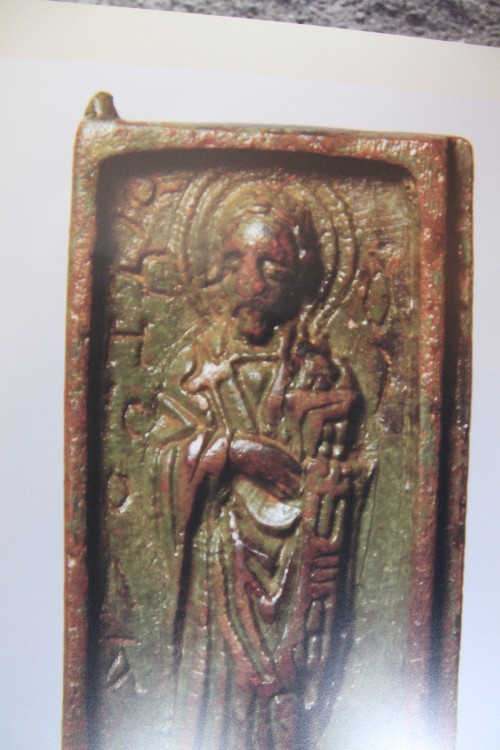
Analysis
This is not your typical Greek! Or maybe runes, or a slavic/germanic language/name, in something similar to the Greek font.
Phoenician/Runes?
Is this alphabet Phoenician or runes? Both derive from the Levant traders. This instance may contain Greek. The information provided says the word NIKA might be visible, `Victory'. There may be some Byzantine influence. Other information at the museum claims the stones are an `Adobe with character-like signs (?), Podoblocie, central Poland.
A loose translation of the museum text:
`Figures on tablets written in the greek alphabet. Letters I X Sigma? might be interpreted as a symbol of jesus christ. The letter N might be part of the word NIKA With such an interpretation the writing might be: `Jesus Christ Conqueror/Victor. It is perhaps the oldest monument of literature in our land, preceding the baptism of Poland [to Christianity] by 100 years."
The baptism of Poland occurred in 966 AD. In other words, since Giecz was already capital in 840s, the artefact is far older than Poland itself.
Question: If this is the case, why the perhaps and maybe? Why are the characters not more obviously written in Greek? Is this another example of outdated cultural diffusionism? Why cannot these be indigenous runes, based on earlier Phoenician script, particularly as the Amber route is so old? Every European nation seems to have possessed their own writing in the dark ages, why not this one? Just a suggestion. If Lech came from the North West as the old legend suggests, they likely had runes anyway.
Furthermore, why should there be a mention of Christ when Poland was yet pagan? Even the Saxons were still pagan.
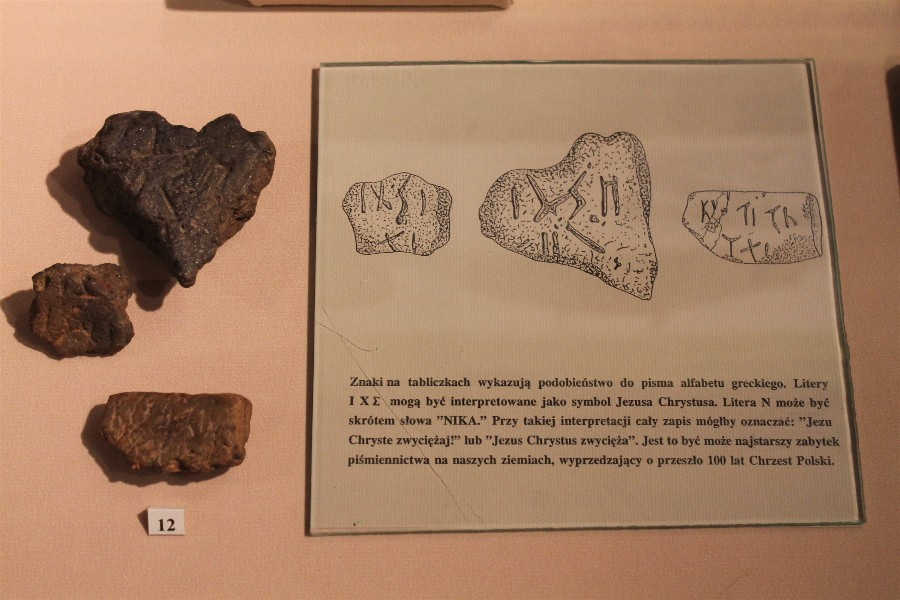
Analysis
The context in which these tablets were found is not made clear in the museum. In comparing with the rune alphabet, it is clear that the two tablets on the left are inscribed in classic Germanic Runes. If we had more of the tablet we might be sure. For now it's a guess but the letters appear to be runes. The tablet on the right has more Greek-looking characters. Allegedly, before slav nations were baptised into Christianity, they had their own form of `strokes and indentations' (also interpreted as tallies and sketches), according to Bulgarian/Byzantine chronicler, Chernorizets Hrabar. He said they`read and divined by means of strokes and incisions, being pagan'. This sounds a little like the tallies found on the Vinka writing. Poles, originally being centred around a Lechite (originating, by tradition from the north west, into Poland), under mythical King Lech, might have used runes anyway. Are these the Lechite runes?
Below, I put together a case for three different alphabets, as found on the inscriptions. It's really impossible to decipher anything here and i'm skeptical of the possible Christian connection for the `third' alphabet. We don't even have full alphabets, yet, or any complete tablet inscriptions, but it would be awesome if more would turn up!
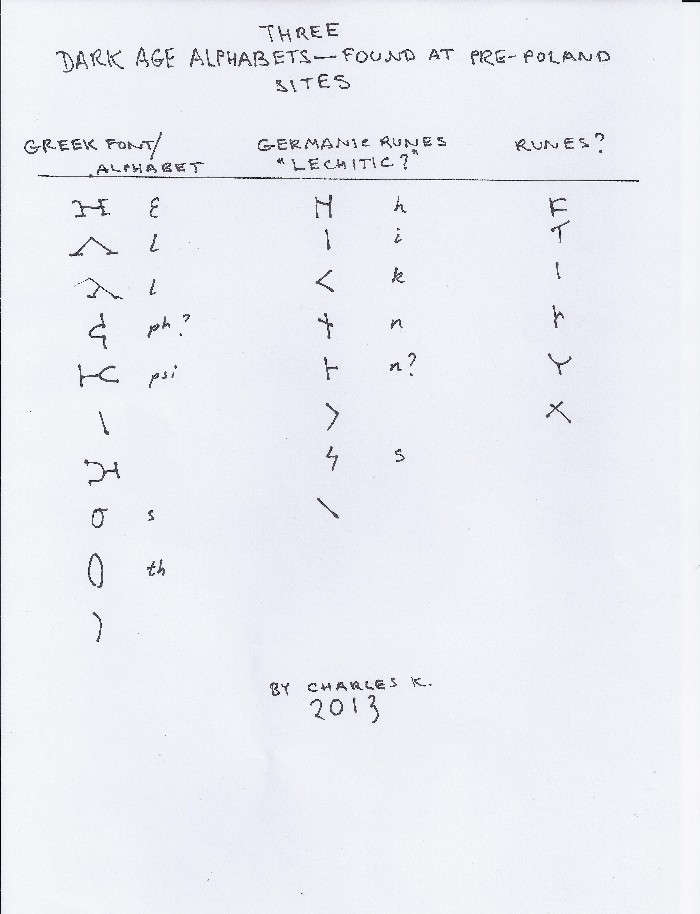
There were other instances of strange alphabets. For example, in the Wawel Royal Cathedral, where coronations were held, I saw wall paintings with some form of Church Slavonic, (Cyrillic characters). I would have thought this would be strange to have been seen in Poland, particularly the most important church in the realm, with crypts of kings.
Slavic Runes, 3/Oct/2013
I was just examining photos from my trip and came across another old alphabet, as seen in a museum. Once again it is found in the Poznan area, the heartland of the early Polish state. Wow! This time these are officially 'Slavonic Runes'! They were first put on display in 1859-9, in Krakov and they come from the village of Mikorzyn, in the province of Great Poland: home also to Biskupin, Giezc, Gniezno and other very early Polish places.
Please take a look at these bizarre inscriptions! To me, they look just as Phoenician and Near Eastern, as they do Germanic. Perhaps they have attributes of both. This is a kind of Slavic alphabet. Coming from an English-speaking background I was amazed to see such things. One doesn't read about them at all in the English-speaking world. There is a kind of blank in the books when it comes to looking at dark age artefacts, because the history is so poorly defined. These definitely deserve more attention outside Poland.
Interestingly a character appears to holding a pyramidion, or is it a type of hat? The hat explanation is more likely. In Hindu mythology, based on an earlier Indo-european mythology (Encyclopaedia Britannica states that some Hindu-like deitites are found as far west as in Irish mythology, 1972) we hear of a giant pyramid-shaped mountain, Mt Meru at the center of seven continents. Perhaps Brahma, or 'world' is holding this. THAT is speculation. The shaved head is interesting or is it just a lazy artist who didn't draw any hair? If we were a strict Occam's-Razorist, we would say that it's just someone holding his hat for some reason... hmmmm. With limited information all we can do is speculate. Oh dear. Maybe this is all a waste of time and the stones are, as some say, 19th-century fakes. They DO look a lot more spectacular than the usual stuff which comes up around Poland.
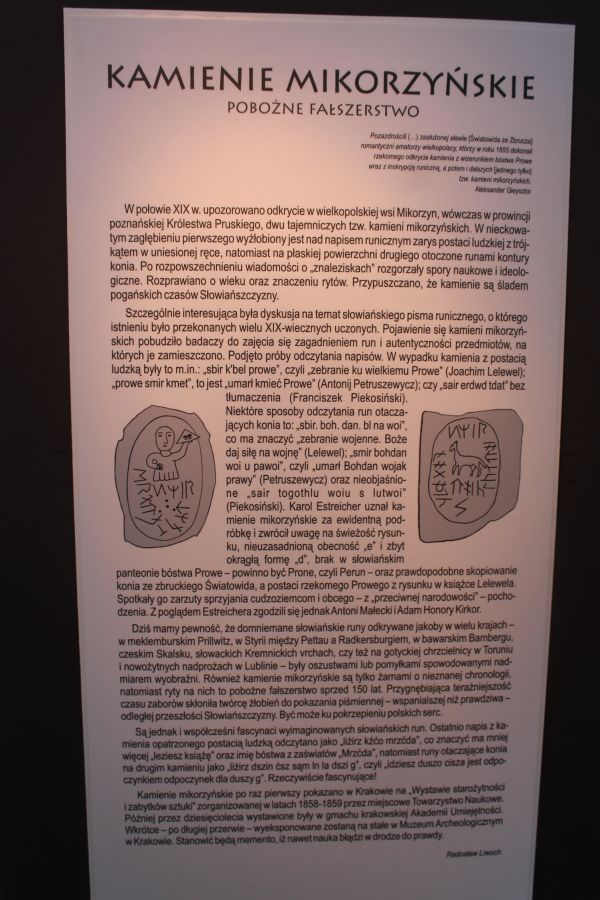
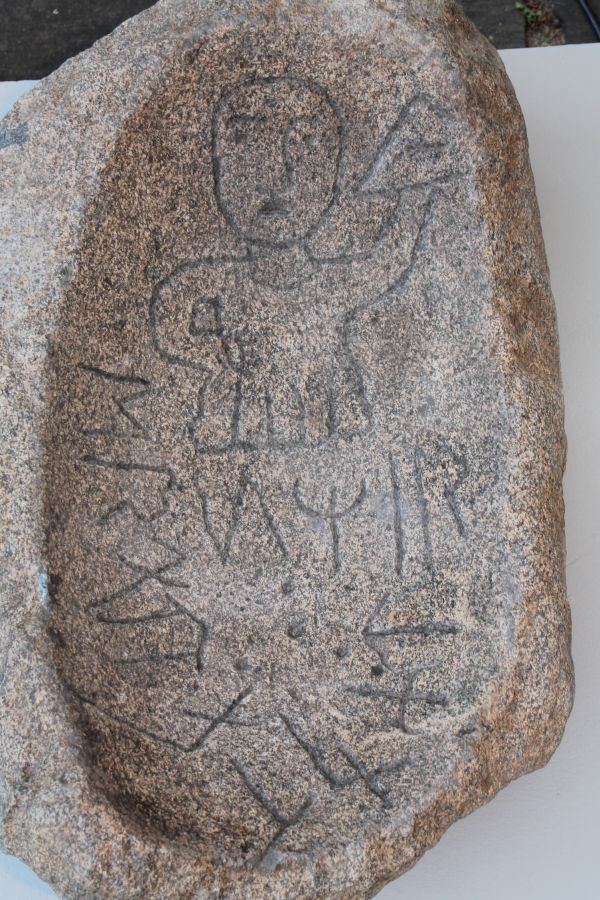

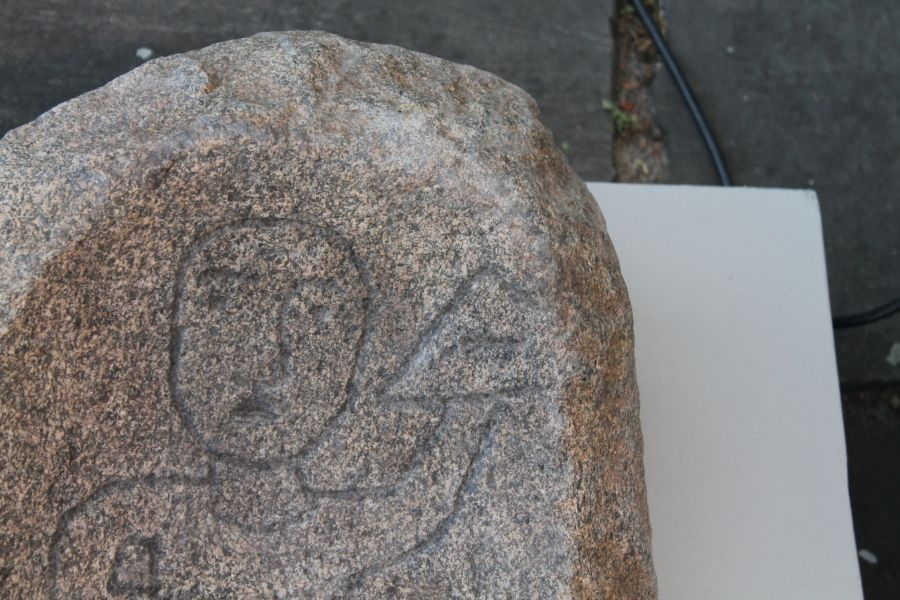
The following is information derived from the museum information, above.
These are Slav runes.
We now know that quite similar runes are found in many nations, all over old slav lands, czeck, slovakia, as well as bavaria.
They were first exhibited in Krakov 150 years ago. Their origin is controvercial. Some say they were faked. Some say they are real. Polish scholars are unsure but they seem to read in slavic.
HORSE:
The supposed letters are given first, then the equivalent Polish, then a translation. Three scholars look at it and attempt to explain what it says:
"sbir. boh. dan. bl na woi" = "zebranie wojenne. Boze day le na woyne' = "God gives strength for war." (Lelewel)
"Sair Togothlu woiu s lutwoi" (Piekosinski does not attempt a translation)
"smir bohdan woi u pawoi" = 'umarl Bohdan wojak prawy" = Died Bohdan(name), soldier right/good.(Petruszewycz)
PYRAMIDION:
Here are three attempts at both the original writing, and a translation. First comes the original, than the Polish equivalent, than the translation. They seem to say something like: 'Great man died'. Hmmm.
"prowe smir kmet'(Original) = 'umarl kmiec Prowe'(Polish) = Died prince Prowe.(Antonij Petruszewycz)
"sbir k'bel prowe' = "zebranie ku wielkiemu Prowe" = Collected to great Prowe(Perun?) (Joachim Lelewel)
"sair erdwd tdat", 'without transaltion' (Franciszek Piekosinski).
Me: That last instance looks like some form of old German, "That sir Edward" (???). OR "Sir Edward died?". 'tdat' looks very much like an inflected past-tense verb at the end of that sentence.
19th century Romantic translations:
Pyramidion: "leziesz ksiaze", = the God from underground, 'Mrzcda'.
Horse: "lizird dszin csz sam In la dszi g' = "idziesz duszo cisza jest odpoczynkiem odpoczynek dla duszy g" = 'Silence is rest for spirit (duszo)'.
......... End of Museum information......
(My Comment: The man with the pyramidion, or hat, missing legs, hence the idea he might be ghost-like?)
Speculation:
The word 'bohdan' is possibly significant. Two scholars seem to come up with it, in one word or divided into separate words boh and dan. THAT is also etymologically significant as a separator. Bog is God and Dan = Da = Give. There is a name in Polish, Bogdansky, which etymologycally probably means "God Gives' Son" or 'Son of God Gives'. That is fascinating! The name is close to 'Buddha'. Obviously in some older Hindi or an older language that means something like 'Enightened', but it's obvious from our own experience that words with different definitions are based upon older etymologies. (Aside: The components of the older etymologies are themselves probably corrupted definitions of what those older words really meant!). Buddha could have initially meant God Gives. Later it came to mean enlightened.
Conclusion:
This will always be controvercial. We don't know what the transaltions really say and obvisouly scholars can't agree with one another. There is no evidence these were not faked so we can't draw anything truly definitive even if we were to find something truly definitive, and conclusive, about what they are trying to say. Despite their position of prominance in the Museum of Archaeology at Cracow, they are probably inadmissable as a singular piece of evidence to base anything upon.
Sarmatians?
There is an interesting quote I saw from Professor Sher Singh, (d. 2009) who is Sikh: "We are Jats and we came from the Scythian race of Central Asia who also perigrinated westwards. You know them as Jutes, or as in Jutland. The same! Vikings and Normans who settled in Yark-shire and Lincolshire. Buddha, Odin, Wodin, Wednesday-the gods were the same. That is our peoples' common ancestry!" (Rushby, K., 'Chasing the Mountain of Light', London 1999, p. 229.).
This leads me to another topic relating to Buddha = 'Bogda'? Is the picture 'buddha'? A monk with shaved head? It's obvious we have had empires stretching from east to west. We've had an Islamic empire, a Persian as well as Hellenistic empires linking the two worlds culturally. My mother noticed that the absence of legs may indicate a yoga posture, a position the Buddha is seen in. He was a practicing Hindu and yogist before coming up with his 'Middle Way'.
Many aspects of Buddhism must be pre-buddhist, just as many aspects of any other religion is based upon universal ideas, such as fasting, as well as themes common to humanity, but more fundamentally upon chosen aspects selected as 'worthy' which are practiced in earlier religions. The fat buddha Gods, (really pre-Buddha but later associated with him), relate to the fools of European tradition, the Friar Tucks? A pre-Buddhist link to Europe is a pet hypothesis of mine. The link is via the Sarmatians: tribes of Central Asia whose empire stretched from Poland to India. My mother just pointed out that Buddha WAS a prince(!) and here we find the word smir, which means prince. I find the idea of early proto-buddhism in the Samaritan world, early on in the west, quite fascinating. There is something to this... in the Tibetan tradition, a new Buddha arises every 5000 years, as a new prophet. Guatama Buddha was the third such prophet. Eventually he rejected the deprivation practices of Hinduism and came up with his own 'Middle Way', or was it a blend of his established tradition with his own invention?
Update!
3/Oct/2013 One of my friends has told me that the runes look Marcomannic. This is a possible Germanic script associated with Northmen, according to a chronicler of over a thousand years ago. There are also the Old Hungarian and Old Turkic alphabets which do look less Germanic than the runes found here, but quite similar! They seem to be Germanic runes mixed with something else, at some stage. The existence of the Vinca writing in a similar area thousands of years earlier suggest an older practice. It's commonly thought that everything stems from Phoenician characters. Sumerians however speak a language which shares loan words with Hungarian, an idea which has led Hungarian nationalist historians to claim it's basically the same language. The Sumerians may have partly come from central asia, as the Hindu Aryans did. Perhaps the related Phoenicians did as well... bringing a language with them. More questions: Did nomadic tribes write? Were they fully nomadic? Will we find central asian cities one day in territories thought to have been inhabited by nomads, or will Herodotus' idea that Scythians build no cities prevail?
Update: 19/6/19 Thank you to Paweł Słomski, who read this article and suggested the following information! "Wojciech Cybulski, PhD did a dissertation on Slav Runes: "O runach słowiańskich. It mentions 'bel' means "biały/biel" which means white and in another place it describes one of our Gods: Belbog/Biały Bóg - White God (there is also Black God/Czarny Bóg mentioned, but author thinks it is falsification - he lived in participation times and our Gods pantheon was not very known then). Furthermore, one of the inscriptions describes Polish name: Bohdan/Bogdan (not Bogdansky) which means: God gives. There is no 'son' in this name. Bogdansky is an unpopular name in Poland."
Cześć!
Powered by FolderCMS







